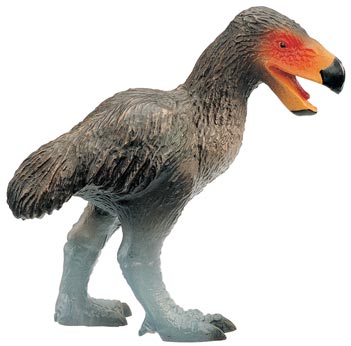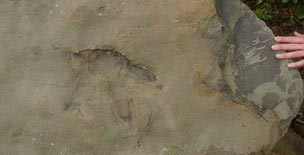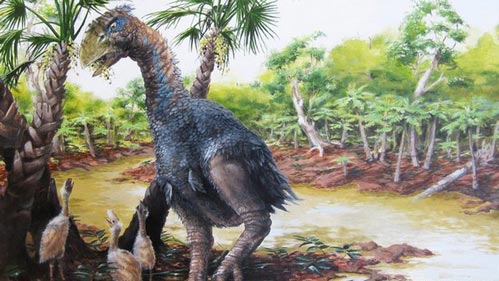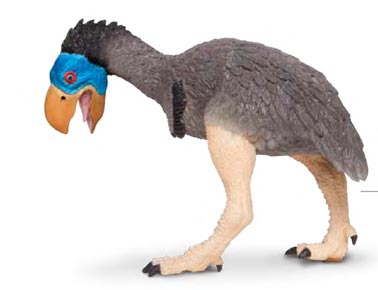Palaeogene Diatryma a Vegetarian
With the extinction of the Dinosauria at the end of the Cretaceous there were a huge number of ecological niches vacated by the likes of the ornithopods and the theropods. For example, with the demise of the dromaeosaurs, abelisaurids and the tyrannosaurids there were no large, entirely terrestrial predators left on Earth. Many scientists have accepted the theory that flightless birds evolved into apex predators, replacing the meat-eating dinosaurs. One such flightless bird, was the giant Gastornis (sometimes referred to as Diatryma).
Standing over 1.75 metres tall, (some scientists suggest that some specimens were over 2.2 metres high), this heavily built bird was believed to be a predator, specialising in ambushing small mammals and other creatures despatching them with its massively powerful beak. However, a team of Washington based scientists have proposed that these giant birds were actually gentle herbivores.
An Illustration of Diatryma/Gastornis
Picture credit: Everything Dinosaur
An examination of three-toed footprints uncovered after a landslide in 2009, that are believed to have been made by a Diatryma-like flightless bird, show that this huge bird did not possess raptor-like claws. The lack of sharp claws could mean that the the huge beak of these birds may not have been the bone-crunching, mammal eating weapon thought of previously, but the sturdy beaks could simply have evolved to crush nuts and fruit. The American scientists propose that these bipeds may have been entirely vegetarian.
Bird Footprints
The bird footprints, were found in sandstone strata of the Chuckanut Formation of Whatcom County (north-western Washington). The tracks were uncovered after a landslide and the strata in this formation dates to the Palaeogene geological period (Lower Eocene around fifty million years ago). The environment was a sub-tropical, flood plain, criss-crossed by many large rivers. The footprints were made by a large, flightless bird as it walked along a riverbank. There were crocodiles and many different types of turtles as well as other species of birds and many small mammals in this environment.
Researchers from Western Washington University, (Bellingham, Washington State), examined the tridactyl prints (three-toed) and have ascribed them to the ichnogenus Rivavipes giganteus, placed in the family of Gastornithidae. An ichnogenus is a genus which is established after the study of fossilised footprints or tracks.
Footprints show no Trace of Talons
Picture credit: D. Tucker/Western Washington University
Giant Birds
Fossils of giant birds dating from the Palaeocene and Eocene Epochs have been found in Europe and the United States. The shape of the beak and the sturdy, muscular body led palaeontologists in the 19th Century to describe these birds as predators, the first of the “Terror Birds”. However, researchers at the American Museum of Natural History (New York), at the end of the 20th century proposed that creatures such as Gastornis and Diatryma may have lunched on fruit and seeds.
This theory was based on the shape of the beak, which they interpreted as being well suited to crushing nuts and other tough plant matter rather than for the tearing of meat. Unlike many predatory birds of today, the beak did not have a curved downward pointing tip. Although the beak was very strong, it did not have the same morphology as those of meat-eating, extant birds such as eagles and ospreys. This contradicted an earlier paper, published in 1991 by American palaeontologists Lawrence Witmer and Kenneth Rose which focused on the biomechanics of the bill of Diatyrma. Witmer and Rose postulated that the powerful jaw muscles and thick bill could only have evolved to crush bone.
One of the authors of the scientific paper describing the footprints, that has just been published in the academic journal “Palaeontology”, George Mustoe stated:
“Let’s be honest, scary, fierce meat-eaters attract a lot more attention than gentle herbivores”.
Studying the Tracks
The tracks show that the bird that made these prints did not have long talons. Such short claws do not seem suited to catching and subduing prey. Carnivorous birds all have sharp, pointed long talons. The short leg bones of Diatryma/Gastornis suggest that this heavy creature, that could have weighed in excess of 400 kilogrammes, would not have been a fast runner. It had been thought that it was a specialist ambush predator, but perhaps it did not need to move very quickly, simply browsing on the plentiful fruit and nuts to be found in the forest.
Washington State around Fifty Million Years Ago – Grazing Giant Birds
Picture credit: Marlin Peterson
The lack of sharp claws on the feet adds to the theory that flightless birds such as Diatryma may have been entirely herbivorous and not the “Terror Birds” as previously thought. According to the Western Washington University scientists, the assumption that Gastornis/Diatryma was a meat-eater, relates to anatomical similarities seen in the later phorusrhacids from South America.
There have been a number of “Terror Bird” models made in recent years, perhaps the most famous is the Bullyland Diatryma/Gastornis, but Safari Ltd will be bringing out a Gastornis replica in 2013, a new addition to their “Prehistoric Life” model series.
New Gastornis Replica Available in 2013
Picture credit: Everything Dinosaur
To view Everything Dinosaur’s range of prehistoric animal models including replicas of Kelenken and Diatryma: CollectA Deluxe/Supreme Prehistoric Animal Replicas.
If the likes of Diatryma/Gastornis were not carnivorous, then this leads us to an interesting conundrum – what type of creatures were the apex predators during the Palaeogene?









Leave A Comment